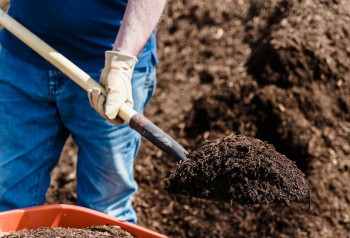How To Lay Turf Part 4: Aftercare
Don’t let your new lawn dry out You will need to keep your new lawn moist at all times. Watering 4 times a day in warm conditions is quite normal. An example schedule would be: early morning mid/late morning late afternoon ... more details
How To Lay Turf Part 3: Installing The Lawn
Apply a starter fertiliser to your soil Once you have a reasonable amount of underlay levelled (we recommend 100mm), apply a starter fertiliser such as Lawn Launcher, this will encourage deeper root growth and really support your lawn in the es... more details
Controlling Invasive Grasses
How to remove invasive turfgrass varieties from your lawn Kikuyu and couch are the number one suspects when it comes to lawn invasion, they are fast growing and have fine seeds that can spread very easily. Kikuyu is more aggressive in nature than an... more details
Turf Delivered To You
Here are some photos of our turf deviery to a North Star Farming property. 400m2 of Sir Walter. We service from Gunnedah to Goondiwindi, Tamworth to Warwick and all places in between. Contact Us... more details
Choosing Kikuyu Grass – 3 Common Mistakes To Avoid
Avoid: Using Kikuyu grass in shady areas Although a well maintained Kikuyu grass lawn could look good in areas of full sun, it doesn’t stand up to shade-affected areas and quite often becomes patchy and dies off. This is particularly crucial w... more details
How To Lay Turf Part 2: Preparation
Complete the rest of your garden first Firstly, if you’re doing a complete garden renovation or creating a brand new garden, complete all other aspects of the garden first, garden edges, retaining walls and paths. Clear the ground and check y... more details
How To Lay Turf Part 1: Measuring
Not sure how much turf you need? Laying turf doesn’t have to be hard – you just have to get the preparation right and your lawn will be looking amazing in no time. Landscaping and turfing demand some skill with numbers, but not much... more details
Spring is an important time to fertilise
Spring is an important time to fertilise, as your lawn breaks the winter dormancy. You need to make sure you don’t get too excited and spread it out too early, so timing is key when applying fertiliser in spring. A nice easy rule to remember i... more details
New Turf Trailer
We have completed the fit out of our new trailer. This 40ft double drop deck trailer will carry 1000m2 of turf to customers across our region. We custom made sections to suit our business and to make it quicker and easier to deliver turf to you. We c... more details
Cracker the Farm Dog Managing the Turf Business
Cracker keeps an eye on the progress of the tractor bringing the next pallet of Sir Walter DNA Certified to be loaded onto the truck at Rivendale Turf. He even helps to tie down the load!! Here at Rivendale Turf, we are proud to partner with Lawn S... more details
What's Happening at Rivendale Turf This Winter?
Look for the Orange Truck! Our business is expanding, and with it comes the need to invest in new wheels to deliver increasing amounts of Rivendale Turf. As well as standing out from the crowd, our orange truck has the capacity to carry bigger loads... more details
Soil Temperatures and Dormancy
You might have noticed your lawn is starting to slowdown in growth, where you are mowing less frequently, and the grass might also have lost a little bit of colour.Most Australian lawns consist of warm-season turfgrasses. Kikuyu and Soft Leaf Buffalo... more details
Fighting Winter Weeds
3 Common Winter WeedsWinter weeds can be a real nuisance and undo all the hard work you put in getting your lawn looking superb during the warmer months.The best time to treat winter weeds in your lawn is during winter. By doing so, you have more cha... more details
Preparing for Winter
During cooler seasons, lawns will generally be at their most vulnerable and unable to repair or maintain good health as well as they can in warmer seasons. In the warmer seasons the grasses are actively growing and during the cooler months they slow ... more details
Frost and your lawn
Frost is the result of the dew freezing on your lawn, which typically occurs in the early morning. The frost can freeze the blade of the leaf and cause significant discolouration. The discolouration occurs as result of the damage caused by the frost ... more details
Rip out and Replace
Where do I start? Select a turf variety that suits your needs To find the best varieties are for your area and for your needs view Our Varieties. Contact us if you have any questions. Plan out a timeframe for completing the new lawn It is i... more details
6 Common Warm Season Weeds
Many small weeds many be carefully pulled out by hand, however you will need to make sure you have removed the roots. Using a weeding trowel or long handled, mechanical device and prizing around the roots will help ensure total removal. The bigger th... more details
Identifying and Treating Lawn Pests
Lawn grubs are leaf eating caterpillars, the larvae of an adult moth. Lawn Grub is a collective term that describe Army Worms, Sod Web-worm and Cutworms. All of these lawn grubs cause similar issues on your otherwise healthy lawn. The worms themsel... more details

















